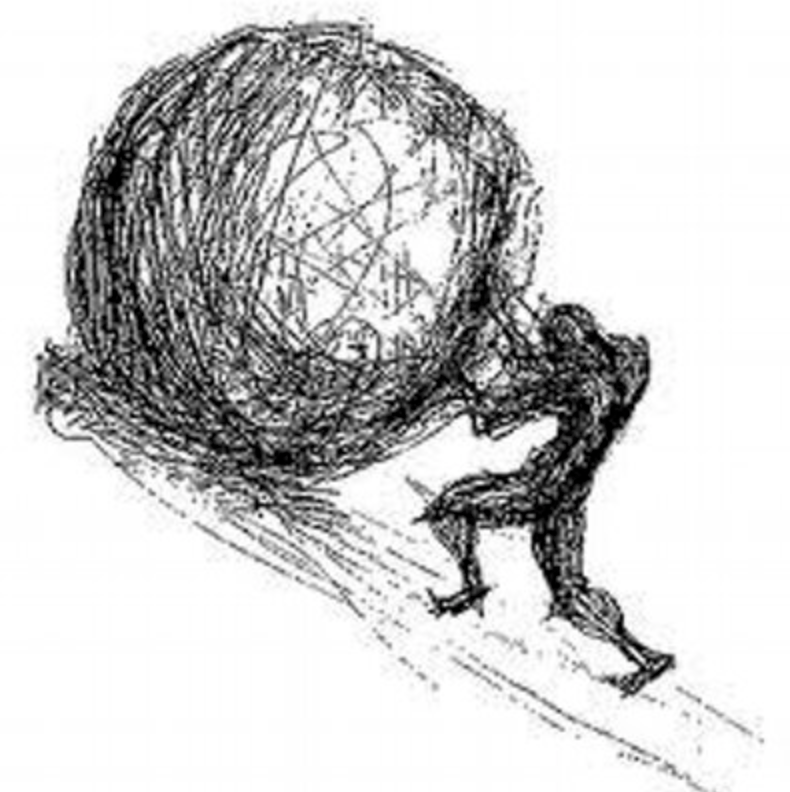Objectives:
- To understand that a system is an object or group of objects and that there are changes in the way energy is stored when a system changes.
- You should be able to describe all the changes involved in the way energy is stored when a system changes, for common situations such as:
- an object projected upwards
- a moving object hitting an obstacle
- an object accelerated by a constant force
- a vehicle slowing down
- bringing water to a boil in an electric kettle.
 Physics gets a bit of a bad reputation for being a difficult subject and this likely largely due to the large quantities of maths involved. However, physicists tend to try to simplify situation and scenarios to simplify things and make their life easier! They do this by referring to specific situations as ‘systems’. A system of particles is, for example, one which does not interact with external objects or forces. Imagine yourself lifting a book up and putting it on the top shelf of a bookshelf,
Physics gets a bit of a bad reputation for being a difficult subject and this likely largely due to the large quantities of maths involved. However, physicists tend to try to simplify situation and scenarios to simplify things and make their life easier! They do this by referring to specific situations as ‘systems’. A system of particles is, for example, one which does not interact with external objects or forces. Imagine yourself lifting a book up and putting it on the top shelf of a bookshelf,
the system involved here would be you, gravity the book and the bookshelf. The reason for
this is, you would be giving the book energy by lifting it up and so you and the book are  definitely involved, the bookshelf holds the book so that’s important but also Earth provides gravity and this points downwards and so gravity is too important because it is forcing the book down. We don’t care about the air around the book or other books on the shelf or the temperature of the room – this would overcomplicate the situation!
definitely involved, the bookshelf holds the book so that’s important but also Earth provides gravity and this points downwards and so gravity is too important because it is forcing the book down. We don’t care about the air around the book or other books on the shelf or the temperature of the room – this would overcomplicate the situation!
In your GCSEs you will consider situations like a skydiver falling from a plane – we don’t care about the wind acting on the sky diver because thats complicated, we do care about air resistance though and gravity. Take a balloon full of air, what happens when you heat it up, or cool it down? In these cases the volume increases or decreases, but again we don’t care about the particles outside of the balloon so much, just those inside it – This is our system.
Storing energy
Storing energy doesn’t at first thought seem to be too difficult – in food for example or in coal, oil and gas. Each type of energy on the previous page that had the term potential energy labelled with it, tells us that that particular type is a ‘store’ of energy. One way to think of this is that the term potential means ‘to have the potential to do something’, for example:
 Chemical potential energy is a store of energy usually in biological forms, we consume this as food and it fuels us for the day ahead.
Chemical potential energy is a store of energy usually in biological forms, we consume this as food and it fuels us for the day ahead.- Elastic potential energy is a store of energy in a stretched spring, this is a store because when released it will release this energy in a different form.
- Nuclear potential energy is a store of energy within the nuclei of atoms, when they f
 use of break apart they can please a store of energy within them, this can be used for light or heat.
use of break apart they can please a store of energy within them, this can be used for light or heat. - Magnetic potential energy, this is a store of energy within the magnetic field of a magnet. It is a store because it is not used unless another magnet is brought in close proximity to it (at which point is attracts or repels).
- Gravitational potential energy is a store of energy in objects that are up high, this is because they have the potential to fall. The higher an object is the further it can potentially fall.
All of these are known as stores of energy. If an object is lifted up in the air and then released, it will fall, the gravitational potential energy store will exchange into kinetic energy. We then call this kinetic energy a store of energy because the object will keep this energy until it comes into contact with something else – it has a increase in its kinetic energy store.
Lets review some common situations and consider the energy changes and stores:
 An object projected upwards: If you were to through a stick up into the air, you will have used your chemical potential energy store and given the stick a kinetic energy store, this then eventually turns into a (gravitational) potential store. On its way back down, this (gravitational) potential energy store reverts back to the kinetic energy store of the stick as it accelerates towards the ground.
An object projected upwards: If you were to through a stick up into the air, you will have used your chemical potential energy store and given the stick a kinetic energy store, this then eventually turns into a (gravitational) potential store. On its way back down, this (gravitational) potential energy store reverts back to the kinetic energy store of the stick as it accelerates towards the ground.- A moving object hitting an obstacle: If you were in a car going along the road you would have energy in your kinetic energy stores. Upon collision with
 another object, this kinetic energy is tranferred to other store like sound energy, thermal energy of the surroundings or the kinetic energy of objects flying off around you.
another object, this kinetic energy is tranferred to other store like sound energy, thermal energy of the surroundings or the kinetic energy of objects flying off around you. - An object accelerated by a constant force: The force applied to an object would allow an object to accelerate, this increases the kinetic energy stores of the object. This energy must have come from somewhere so it would have come from another store of energy either in the form of chemical potential energy or perhaps another form of kinetic energy store from another object.
- A vehicle slowing down: When an object decreases in speed it already has a kinetic energy
 store but it needs to get rid of it to slow down. This can happen by breaking or putting friction on the vehicle, this can dissipate the kinetic energy into other forms, such a thermal energy or sound energy. This then allows the kinetic energy store to decrease and hence to slow the vehicle down. This is why some car brake pads sometimes glow red hot.
store but it needs to get rid of it to slow down. This can happen by breaking or putting friction on the vehicle, this can dissipate the kinetic energy into other forms, such a thermal energy or sound energy. This then allows the kinetic energy store to decrease and hence to slow the vehicle down. This is why some car brake pads sometimes glow red hot.  Bringing water to a boil in an electric kettle: Energy in the form of electrical energy is given to the kettle which increases the thermal energy store. This is then transferred to the water increases the kinetic and potential energy stores of the water itself. This process continues until the water gets to about
Bringing water to a boil in an electric kettle: Energy in the form of electrical energy is given to the kettle which increases the thermal energy store. This is then transferred to the water increases the kinetic and potential energy stores of the water itself. This process continues until the water gets to about at which point the kettles should switch itself off.
There is no guessing the type of scenario you will get in an exam, but the key is just to think that the energy has to come from one original source and is transferred into another form that is useful to the needs of the user.
Earlier on you studied the idea of a system. As mentioned, physicists like to simplify scenarios by ignore negative effects that make things confusing. However, they are realistic! Take the each scenarios (1 – 5) above. Where will energy be lost in each case?
- Air resistance will slow the stick down. This means some kinetic energy store will go into the kinetic energy stores of the air around the stick.
- The kinetic energy stores in a collision are given to objects, including people inside the vehicle – sometimes they can continue moving forward until they hit something in front of them.
- An object being accelerated by a constant force will have to overcome more and more air resistance and therefore there will be some of the kinetic energy stores gained by the object given to air particles around it (when the object hits those air particles)
- When a vehicle slows down, some energy will go into sound energy – but we like to consider it all going into thermal energy (because it is easier to deal with mathematically)
- Kettles make noise, so some of the electrical energy will go into sound energy and light energy (to illuminate the kettle as shown in the picture.
In other words, most devises and energy transfers are not 100% efficient! Energy is often water in other forms.
Take a traditional filament light bulb (one that the wire inside glows red hot). These are incredibly inefficient – they transfer most of their energy as thermal energy. In fact, in some cases where of energy is give to one of these bulbs, only
is transferred to light energy. The other
is transferred to thermal energy stores.
To emphasise this efficiency (or inefficiency in this case), we can draw Sankey diagrams.
 The left hadn’t side shows the input energy and the right hand side shows the output energy. Where an arrows continues in a straight line, this is the useful energy and where it bends downwards you have the wasted energy of the system.
The left hadn’t side shows the input energy and the right hand side shows the output energy. Where an arrows continues in a straight line, this is the useful energy and where it bends downwards you have the wasted energy of the system.
This diagram can also be used with an efficiency equation to determine the percentage efficiency of a system or component. The equation is:
Using the light bulb scenario. the percentage efficiency can be determined by doing:
This equation is exactly the same equation you would use when determining your percentage in an exam. You would take the total (good) marks you got, divide it by the total marks available and then multiply by 100:
Throughout this section on Energy students should be able to calculate the changes in energy involved when a system is changed by:
- heating
- work done by forces
- work done when a current flows
- use calculations to show on a common scale how the overall energy in a system is redistributed when the system is changed.


You must be logged in to post a comment.